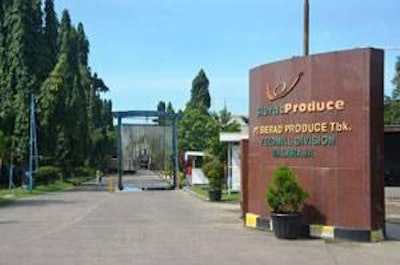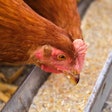
Launched in 1985 in Indonesia as a poultry breeding farm, Sierad Produce has grown steadily over the last quarter century, and its growth within the poultry and feed markets doesn’t appear to be slowing anytime soon. Sierad Produce now consists of a fully integrated poultry production operation, including three feed mills of impressive scope.
“We opened three big breeding farms last year and two more are being built this year in the Banten Province,” explained Elies Lestari Setiawan, Sierad head of corporation secretary, corporate finance. “We are hoping for growth of between 20 percent and 30 percent in volume. Indonesia needs birds but the market is fluctuating, with prices going from 8,000 to 17,000 Indonesian rupiah per bird with an average of 13,000 IDR.”
As Sierad continues its ambitious expansion in poultry production, its feed production is keeping pace with the aid of technology and careful planning.
Mills throughout Indonesia
Sierad owns three feed mills in Indonesia, the biggest being in East Java. The PT Sierad feed plant of Balajara (in Jakarta) was built in 1993, and is dedicated to broiler and layer feeds. Its sister plant, in Lampong, was built in 1997, but, with the Avian flu crisis at that time, it only became operational a year later. Its feed capacity comes close to 800,000 metric tons a year. Sierad chose to fully computer automate the plant to ensure consistent production quality and operational efficiency at all stages of production.
The Balajara plant runs with two teams and deliveries are done by lorries to 2,000 farms. The main worries at the feed plants are supply costs and electricity shortage. “Corn is our main raw material, representing around 50 percent of formulas,” Elies said. “We don’t produce enough of it in Indonesia, and we must import it, as we do soybean meal and even fish meal. Small fishers provide the local production of fish meal but do not meet the demand either in quality or in quantity. So our group invests in this production. We’re also our own supplier of poultry byproducts.”
Palm oil is not used often, as Sierad made the choice to use full-fat soya. “It is very digestible for chicken and has an influence on the meat quality. It has a good value in our Brill formulation system,” Elies said.
Raw material
The total raw material storage capacity comes close to 60,000 metric tons, with 13 storage bins of 2,000 pounds and a storehouse for some bulk, like full-fat soya, and bags. “We need to reach a capacity of 100,000 tons because of shortage risk. We need to be able to produce,” explains Elies. The biggest feed plant of Lampong already has 12 bins of 3,000 pounds and 23 bins of 2,000 pounds, a strategic move for maintaining a supply of raw material. “We’ve also invested in a corn dryer to improve our supply security.”
Traceability of every batch of raw material is assured and will soon be implemented in the automatic system (provided by Actenium). Samples are taken from each delivery of raw material and the plant has its own laboratory. Storage control will soon be automated in connection with the general automation of the plant. The raw material stock is updated as soon as a batch is produced.
Mill equipment
The pre-grinding feed plant has three lines with a dosage bin, two mixers and three CPM pellet mills. The liquid-addition automation system (Bredol) is separate from the general automation process, but the data is sent to a supervisor in order to maintain control of the entire process. The moisture target is 11 percent and spraying of anti-mold is common. Enzymes are included in powder.
Steam production is provided by a boiler fed with palm kernels. At one time, palm kernels were considered waste, but, in fact, they provide good thermal efficiency.
Expansion
In December 2011, Sierad signed a loan agreement with PT Bank Muamalat Indonesia for 100 billion IDR to build four commercial farms. When it is fully operating, the Lebak Regency Breeding farm will regroup with five farms and one hatchery on an area of approximately 250 hectares. Its hatchery facilities already hatch 120 million eggs per annum, and its breeding facilities produce up to 105 million day-old chicks every year.
Sierad also has technical services to assist in feed use and farming efficiency. Feed produced by Sierad is directed either to its own farms or to commercial farms. Although the biggest player in Indonesia, CP Group, is fully integrated, Indonesia, nonetheless, maintains a free poultry market that Sierad is able to serve.
Contract growing program
Sierad is building a contract growing program for poultry farmers that own facilities with a minimum of 5,000 birds. The program provides birds, health care products, feed and technical assistance during growth and logistical support for distribution of full-grown chickens. Sierad also owns two slaughterhouses, whose total capacity reaches 10,000 birds an hour.
“In Indonesia, consumers prefer fresh chicken to processed products. Nevertheless, we can sometimes adjust our volume with our frozen capacity when prices are very low,” Elies adds. The bird flu crisis in 2007 temporarily changed the market; during that time, no live bird entered the city. Fortunately, the Sierad slaughterhouses are in the suburbs so the company was able to continue running without interruption.
Sierad has also developed processing facilities to enlarge its range. In this area, it chose to go directly to consumers with a group of 45 retail shops. “We sell either fresh or transformed products in those shops,” Elies said. “Under a global concept of ‘partner for your kitchen,’ our places also sell rice, vegetables and spices.” The network is growing steadily.

















